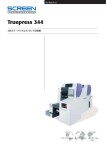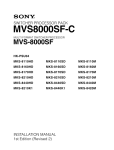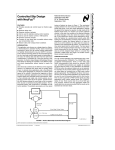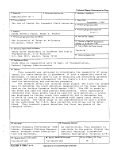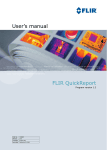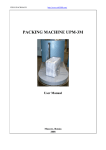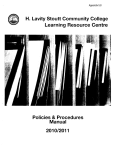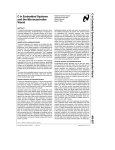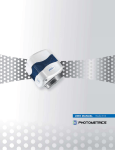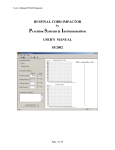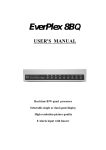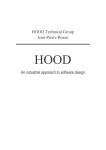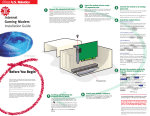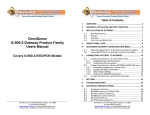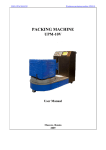Download AN-664 ISDN Basic Rate Interface Terminal
Transcript
AN-664 ISDN Basic Rate Interface Terminal Equipment (TE) System Design Guide Literature Number: SNLA018 National Semiconductor Application Note 664 Telenetworks February 1990 PREFACE This System Design Guide is intended to aid a system design engineer in implementing an ISDN Basic Rate Interface (BRI) Terminal Equipment (TE) application. The Design Guide is divided into the following sections: 1.0 ISDN Basic Rate Interface Overview 2.0 ISDN BRI Terminal Equipment Functional Requirements 3.0 ISDN BRI Terminal Equipment Design Solution 4.0 Summary Section 1 is intended to introduce ISDN BRI and to give some justification for implementing such an application. Section 2 presents the necessary hardware and software functional subsystems, without getting into specific implementation details. Section 3 presents a design solution for the ISDN BRI application, introducing the National Semiconductor HPC16400E Microcontroller along with the Telenetworks ISDN software packages. Section 4 summarizes the ideas presented in this System Design Guide. References for this System Design Guide are found in Appendix A. For more information regarding ISDN BRI implementations contact your local National Semiconductor representative or contact Telenetworks at (707) 778-6500. analog Centrex service offerings. For ISDN to be truly successful, cost-effective end-user applications must be developed and supported that require the extended services that are only available through ISDN, e.g., Keyset services, Userto-User data, and telemetry services on the D channel. The DIGITAL part of ISDN provides three digital channels (B1, B2 and D) between the Customer Premise Equipment (CPE) terminals and the Central Office. Any combination of voice and/or data services can be provided on either of the two bearer channels, while both signaling and data can be sent over the D channel. For example, two voice circuits can be implemented over the same wire pair that previously only supported one. Data can be sent at up to 64 kbits/second, rather than the current nominal rate of 2400 baud using a modem. End-to-end digitized information is less susceptible to noise, allowing for clearer voice quality and less data retransmissions. Several data links running at sub-rates (less than 64 kbits/second) can be multiplexed onto a B channel or the D channel using various time division multiplexing techniques not available in the analog domain, thus taking full advantage of the channel bandwidth. The NETWORK part of ISDN includes marketing and tariffing issues. For ISDN to be successful digital facilities must be available from end-to-end, i.e., no isolated ISDN islands. The network must provide signaling and bearer services throughout the country (and eventually the world), using Signaling System Ý7 as the inter-office backbone. The network is also responsible for the appropriate billing mechanisms for the ISDN services. User-driven applications must be developed and supported by the network, along with a cost-effective tariffing structure. BRI ISDN will slowly become available to the general public. It is currently being deployed in large metropolitan areas, targeted for business environments. Just when more general deployment will occur depends on the rate of depreciation of current equipment, tariffing rates for the ISDN services, and user acceptance of the new ISDN technology. End-users are just now becoming educated on the virtues of ISDN. Ultimately, the end-users will have to drive OEM vendors to provide ISDN terminal equipment that brings special services to them. These services will have to either cost less than currently available services, or be value-added and cost effective. The remainder of this document provides OEM vendors with an idea of what is involved in designing an ISDN BRI terminal, and what ‘‘building blocks’’ are available for implementing such a terminal. There are several types of ISDN Terminal Equipment (TE). TEs can be Voice and/or Data; PC-based or stand-alone; synchronous and/or asynchronous; 0B a D, 1B a D, or 2B a D; X.25, V.120, or V.110, or any combination of data protocol support. Figure 1 shows a generic stand-alone voice/data terminal configuration. 1.0 ISDN BASIC RATE INTERFACE OVERVIEW The Integrated Services Digital Network (ISDN) Basic Rate Interface (BRI) provides a replacement for the current subscriber line interface offering into businesses and homes. As shown in Figure 1 , the ISDN BRI offering uses the same copper pair as the current conventional phones, but provides more and better services to the subscriber. To harness these services it is necessary to follow the prescribed layered protocols for developing ISDN BRI Terminal Equipment (TE). This System Design Guide functionally defines these protocols and proposes an implementation solution for a particular ISDN BRI terminal design. This section defines what ISDN BRI services are and why they are worth the investment in a new technology. The INTEGRATED part of ISDN is apparent in two domains: the integration of voice and data on the same interface, and the integration of an out-of-band signaling (D) channel with the bearer (B) channels. The advantages of this integration are defined in the following paragraphs. The SERVICES part of ISDN are the main reason for ISDN’s potential growth and acceptance in the future. Basic Voice and Basic Data services, and even the ‘‘Big 4’’ Supplementary Services (HOLD/RETRIEVE, CONFERENCE, DROP, and TRANSFER), are not enough to propagate the ISDN cause. All of these services are available with the current AN-664 MICROWIREÉ is a registered trademark of National Semiconductor Corporation. COMBOTM and MOLETM are trademarks of National Semiconductor Corporation. C1995 National Semiconductor Corporation TL/H/10726 ISDN Basic Rate Interface Terminal Equipment (TE) System Design Guide ISDN Basic Rate Interface Terminal Equipment (TE) System Design Guide RRD-B30M75/Printed in U. S. A. ISDN Basic Rate Interface Terminal Equipment Application TL/H/10726 – 1 FIGURE 1 2 synchronous data applications a USART is required, along with an HDLC Software Driver module to control the interface. 2.0 ISDN BRI TERMINAL EQUIPMENT FUNCTIONAL REQUIREMENTS The ISDN BRI Terminal Equipment (TE) Functional Requirements are layered, in accordance with the OSI Layered Model. ISDN applications include requirements at the Physical Layer, the Data Link Layer, the Network Layer and the Application Layer. Figure 2 reflects these layered functions for each of the following subsystems: the Digital Subscriber Signaling System Ý1 (DSS1) protocol requirements, the data protocol termination requirements, and the Maintenance and Management requirements. Several types of data protocols exist today (e.g., X.25, V.120, V.110, DMI, and T-Link). This System Design Guide focuses on the requirements necessary to design an ISDN BRI voice/data terminal, using the X.25 asynchronous and synchronous data protocol for terminal adaptation. The definition of the layered requirements for the other forementioned data protocols is beyond the scope of this Design Guide. The X.25 data protocol was chosen because it is the most prevalent data protocol today, as well as the best defined protocol. The requirements for transporting X.25 data on an ISDN BRI terminal are defined as part of this paper and are more generally defined in CCITT Recommendation X.31. In some applications it is not desirable to hard-wire a particular bearer channel to the CODEC or to the HDLC port. In these cases it may be necessary to provide a switching device to dynamically switch a bearer channel to either of the two sources. Semiconductor vendors have developed several types of internal digital formats that allow these various devices to communicate. Serial decoding is the physical layer function that presents the S interface data to the particular devices. Care must be taken to ensure that the selected Layer 1 devices all provide the appropriate digital format. 2.3 Link Layer Requirements The OSI Link Layer (2) is defined by two sets of procedures: High-Level Data Link Control (HDLC) procedures and Link Access Procedures (LAP). HDLC procedures are typically done in hardware with synchronous channel controllers. Link Access Procedures are typically done in software, although some silicon devices do offer limited LAP functionality. As shown in Figure 2 , two HDLC Controllers are required: one to terminate the D Channel and one to terminate one of the Bearer Channels for data. HDLC software device drivers are needed to control both of these HDLC channels. From a software implementation point of view, DMA controlled HDLC channels are much more desirable than FIFO-based channels because they ease the CPU interaction requirements. The D Channel termination at Layer 2 requires implementation of the Line Access Procedures of CCITT Recommendation Q.921, more commonly referred to as LAPD. LAPD provides in-sequence, error-free transmission of frames to the higher layers. LAPD can handle multiple logical links. For the ISDN BRI there are at least three logical links, one for signaling functions (SAPI e 0, TEI e X), one for maintenance functions (SAPI e 63, TEI e 127), and one for D channel data (SAPI e 16, TEI e Y). ‘‘X’’ and ‘‘Y’’ are arbitrary, but valid, TEI assignment values. The X.25 B Channel data termination at Layer 2 requires implementation of the Link Access Procedures of CCITT Recommendation X.25, more commonly referred to as LAPB. Like LAPD, LAPB also provides in-sequence, errorfree frames to the higher layers. LAPB can only handle one logical link at Layer 2. 2.1 System-Level Requirements A relatively powerful CPU engine is necessary to process the DSS1 and data communication protocols. Small 8-bit microcontrollers are not generally adequate for the task. On the order of 128 kbytes of ROM are necessary to implement these CCITT protocol requirements, assuming the code is compiled from a high-level language such as ‘‘C’’. Careful consideration must be given to controlling an ISDN BRI application. There are several asynchronous, detailed processes going on that require some level of coordination regarding process scheduling, buffer management, message passing, and timer handling. Selection of an adequate design environment in which to nest the various processes is of utmost importance. Use of a multitasking executive is recommended. 2.2 Physical Layer Requirements To make a terminal a member of the ISDN passive ‘‘S’’ Interface bus a front end ‘‘S’’ interface device is necessary. This device must allow for D channel contention and understand the framing channel. Such a device will take varying degrees of software intervention and control, depending on the device architecture. The I.430 activation (and optionally deactivation) sequence must be followed to initialize the ‘‘S’’ interface device of an ISDN BRI terminal. For a voice application, a CODEC is needed to convert analog voice into digital PCM. A keypad and hookswitch, along with a display, are also required. Some software intervention is necessary to activate and deactivate these devices, debounce hardware inputs, and control these devices. A call progress tone generator is also required to ‘‘play’’ progress tones (e.g., DIALTONE, BUSY, and RINGBACK) to the ear. A set of telephony device driver modules must be available to interface to these hardware devices. For data applications, hardware and software drivers are needed to control the R interface devices. For asynchronous data applications a UART is required, along with a UART Software Driver module to control the interface. For 2.4 Network Layer Requirements The ISDN DSS1 D Channel signaling termination at Layer 3 requires implementation of the Protocol Control procedures of CCITT Recommendation Q.931. These procedures include setting up and tearing down local access connections between the terminal and the Central Office. These connections can be for voice or data services and can be requested for the BRI B or D channels. For X.25 data calls all packets must be processed by the Layer 3 Packet Layer Process (PLP). These procedures include setting up and tearing down virtual packet switch connections between end-to-end X.25 terminals. These virtual connections are established ‘‘in-band’’ during the X.25 call setup phase. 3 ISDN Basic Rate Interface Terminal Equipment (TE) Functional Requirements TL/H/10726 – 2 FIGURE 2 4 Procedures from I.430 are necessary to activate and optionally deactivate terminals on the ‘‘S’’ Interface. Procedures for TEI assignment are defined in CCITT Recommendation Q.921, and in the AT&T and NTI switch specifications. Parameter negotiation procedures are also defined in these switch specifications. For any BRI implementation, extensions must be made to the Maintenance and Management functions beyond what is defined in specifications. It is generally prudent to introduce a UART-based maintenance interface into a design of this complexity. This interface allows for message tracing, limited process interaction, and optional program download and debug capability all from a PC or terminal attached to the UART. A maintenance interface software driver module is needed to manage the screen output and keyboard input functions for the terminal attached to the UART. This interface can be shared with the asynchronous data application, only being available when the data application is not operating. 2.5 Application Layer Requirements As mentioned above, for the sake of this System Design Guide a hypothetical stand-alone ISDN voice/data terminal (TE) will be defined that allows voice or data services on either of the two bearer (B) channels. It will support synchronous and asynchronous X.25 data connections on either bearer channel, and asynchronous data on the D signaling channel. A Basic Rate Interface Application Controller is required that includes the Call Control procedures of Q.931 and X.31. This controller keeps track of which protocol is on which channel. It must also interface to the I/O device drivers for the asynchronous and synchronous terminals, as well as the voice-related telephony hardware. For the X.25 asynchronous data application the TE expects a data application to be running on a PC connected via the ‘‘R’’ interface, a local UART. The TE intercepts commands across the ‘‘R’’ interface and translates them into DSS1 Setup and Teardown commands. Service can be requested for either the B or D channel. Once a channel is setup, then the data phase (packet transfer) is established with the X.25 PLP. When data transfer is complete the PC Application will disconnect with a particular command which will be translated into a DSS1 release sequence, at which time the channel will be available for another service. For the X.25 synchronous data application a synchronous X.25 DTE is expected at the other side of the ‘‘R’’ interface. A USART is required with a special HDLC device driver module to terminate the 56 kbit/second data stream. The driver initially monitors the link for a link establishment indication (SABM). If the DTE requests service first, (link establishment indication is sent by the DTE), an ISDN bearer channel is requested via the DSS1 protocol on the D channel. If the network requests service first the network will setup the bearer channel using the DSS1 protocol, and then establish the data link in-band with the DTE. After successful setup of a B channel, packets are sent between the DTE and the packet handler. At the end of the data session the network side is expected to disconnect the data link in-band (with a Layer 2 DISC command) and then release the call using DSS1 release procedures. Voice service is controlled entirely within the TE. During the time that synchronous data service is being provided on one of the B channels, it is recommended that the TE only allow asynchronous data service on the D channel to avoid voice service from being blocked. In a passive bus arrangement, i.e., multiple TEs on the same S interface, it is recommended that asynchronous data service only be allowed on the D channel. Of course this is a decision that must be made, and enforced, at the application layer. 3.0 ISDN BRI TERMINAL EQUIPMENT DESIGN SOLUTION Figure 3 presents an implementation solution for the ISDN BRI Terminal Equipment (TE) requirements. The solution revolves around the National Semiconductor HPC16400E Microcontroller and the Telenetworks ISDN Software packages. Hardware Solution # NSC HPC16400E Powerful 16-Bit Microcontroller: 2 Onboard HDLC/DMA Controllers 1 Onboard UART 4 Onboard Timers Synchronous Serial Time-Slot Decoder General Purpose I/O Ports 8 Prioritized Interrupt Levels MICROWIREÉ Interface # NSC TP3420 S Interface Device (SID) # NSC TP3076 COMBOTM Codec # USART Software Solution Telenetworks ISDN Software Off-the-Shelf Packages MTEX Multitasking Executive I.430 BRI Layer 1 Driver HPC16400E Dual HDLC/DMA Driver Layer 2 Task Layer 3 Q.931 Task X.25 Packet Layer Process Task Prototype X.31/Q.931 Call Control Task Basic Management Entity Task HPC16400E UART Driver Custom Software Development (by Telenetworks or OEM) USART HDLC Driver Application Specific X.31/Q.931 Call Control Task Command Translator/PAD Task Extended Management Entity Task Extended Applications for Supplementary Services Telephony Device Drivers 2.6 Maintenance and Management Requirements Every application of this magnitude requires some degree of maintenance and management. Some maintenance functionality is required by the Network, while some of the functionality is strictly application dependent. The major maintenance functions include provisioning the TE, statistic collection and reporting, physical layer alarm reporting and recovery, protocol breakdown recovery, and resource depletion handling. Other peripheral maintenance functions include loopback mechanisms, human interface capability, and software PROM revision maintenance. 5 ISDN Basic Rate Interface NSC TE System Solution TL/H/10726 – 3 FIGURE 3 6 3.1 System-Level Solution 3.3 Link Layer Solution The NSC HPC16400E is a powerful 16-bit CPU engine that is fully capable of processing the DSS1 and B-Channel data communication protocols. The HPC16400E has two flexible onboard HDLC/DMA controller channels that are ideal for terminating the D Channel and data on a B channel. It has an onboard UART to terminate the asynchronous data interface, 4 onboard timers, and several general purpose I/O pins. The HPC16400E can address 544 kbytes of memory space, however for the ISDN BRI application the entire memory space should be less than 128 kbytes. An off-the-shelf Multitasking Executive, MTEX, that was designed specifically for controlling ISDN BRI terminal applications has been hosted on the HPC16400E. MTEX has the following subsystems: Task Scheduler Mail Manager Timer Handler Memory Manager. MTEX was designed to provide an environment for communication protocol applications, with special built-in features to handle timers and flow control. Processes, such as Layer 2 Link Access Procedures and Layer 3 protocols, are designed as tasks running under MTEX. Intertask messaging is via the MTEX Mail utilities. MTEX also provides memory management utilities for buffer management. The HPC16400E has two independent HDLC/DMA controller channels integrated onboard with the Central Processing Unit. For ISDN BRI applications, one channel runs at 16 kbits/second for the D Channel, the other runs at 64 kbits/second for data on a B Channel. The DMA Controllers receive and transmit entire frames prior to interrupting the processor. This allows for a much simpler Layer 2 Driver design than would a FIFO-based HDLC controller. The HPC16400E has several other features which ease the implementation of the ISDN BRI application. These features are defined in the following paragraphs. The HPC16400E can operate in a special split field mode where the Layer 2 Header data is placed in one buffer, while the following Layer 3 Information data is placed in another buffer. This feature eases the memory management requirements of an application and decreases the need for copying messages from buffer to buffer. If the split field feature is not used then HPC16400E DMA chaining features can be fully exploited to simplify the application design. On the receive side, four buffers can be made available for incoming frames. When a frame arrives, an interrupt is generated by the DMA Controller. While the processor is responding to the interrupt and fielding the current message, new frames that arrive will automatically be placed into memory buffers. Up to 4 messages can arrive without any processor intervention. On the transmit side two messages can be output, delimited by a closing/opening flag, without processor intervention. If the split field feature described above is used then two frames can be chained on the receive side, with no chaining available on the transmit side. The HPC16400E can be programmed to recognize particular Layer 2 addresses (SAPI-TEI combinations). This feature is useful if the terminal is to be used in a passive bus arrangement. In such an arrangement messages not intended for a particular terminal on the bus can be filtered by the terminal and discarded without any processor intervention. The two HDLC/DMA channels are controlled by an off-theshelf HPC16400E Dual HDLC/DMA software driver module. The driver consists of an Interrupt Service Routine, and two Service Request Tasks, one for each channel. The driver is responsible for initializing the synchronous channel hardware, and controlling the transmission and reception of frames. It is also required to handle buffer management for messages in both directions. Buffers must be allocated for incoming messages and deallocated after the transmission of outbound messages. One exception to this rule is that after transmission, I frame buffers are NOT deallocated by the Driver since they may need to be retransmitted if unacknowledged. The Layer 2 Software Module has the responsibility for deallocating transmitted I frame buffers when the appropriate acknowledgement is received. This driver configures both HPC16400E HDLC/DMA channels to use the split field feature. The D Channel is terminated at Layer 2 with the off-theshelf Layer 2 Software Task providing the LAPD solution. The LAPD was prototyped after the CCITT 1988 Blue Book version for Q.921, however it has been tailored to implement the Layer 2 Specifications in the 5ESS 5E5 generic software release from AT&T, and the DMS100 BCS-28 generic software release from Northern Telecom. LAPD logical entities are defined based on SAPI and TEI. 3.2 Physical Layer Solution The National Semiconductor ‘‘S’’ Interface Device (SIDTP3420) terminates the ‘‘S’’ Interface at the physical layer. The off-the-shelf I.430 BRI Layer 1 software driver module is available to control the SID as defined by CCITT recommendation I.430. The SID also has a built-in mechanism for ‘‘switching’’ the bearer channels upon command. The SID communicates with the NSC HPC16400E via NSC’s MICROWIRE interface. The MICROWIRE interface is a threewire serial interface (SI, SO, and CLK). The NSC COMBO Codec, TP3076 can be used for terminating the voice path in the TE and converts to analog voice signals. The COMBO communicates via the MICROWIRE interface. The HPC16400E onboard UART is ideal for the asynchronous data interface and for the maintenance interface. The UART has a high resolution clock for rates up to 19.2 kbaud. An off-the-shelf HPC16400E UART software driver module is available that interfaces to this UART. This driver fields messages from tasks and outputs them to the UART, as well as receiving input from the UART and sending it to the appropriate task. A synchronous communication device is needed to terminate the synchronous data interface. NSC makes a standalone USART for just this purpose, the TP3460. A special USART HDLC software driver module is needed to control the USART and monitor the interface for particular commands. The requirements for this driver are defined below in the synchronous data application section of this document. Custom Layer 1 Telephony drivers and routines are needed to control such things as hookswitch, keypad input, LCD or LED updates, local tone generation, power ringing, and various other application dependent telephony device requirements. The HPC16400E has a programmable onboard Serial TimeSlot Decoder that provides an interface to the B and D channels of several popular chip-to-chip interface formats. 7 either case, the X.25 link is released, and then the ISDN facility is released using the DSS1 call clearing procedures. The B Channel is also terminated at Layer 2 with the off-theshelf Layer 2 Software Task providing the LAPB solution. The LAPB was prototyped after the CCITT 1988 Blue Book version for X.25 Layer 2. 3.5.2 Synchronous Data Application For this X.25 synchronous data application example the TE expects to communicate with an X.25 Data Terminal Equipment (DTE) running synchronous 56 kbits/second data. A synchronous channel controller device (USART) terminates the ‘‘R’’ interface. A custom USART device driver module will be needed to control the USART and to monitor certain data control commands. When an X.25 DTE requests service it typically sends a Layer 2 LAPB SABM command to establish the data link. The USART HDLC driver module intercepts this SABM and sends a data control service request to the X.31/Q.931 Call Control Task. This message prompts the Call Control Task to set up an ISDN bearer channel using the DSS1 call setup procedures. Once the call setup sequence has reached the ACTIVE state then the Call Control Task sends a message to the USART HDLC driver module that a bearer channel is available. The USART driver then sends the SABM directly to the HPC16400E HDLC driver module. The network side can also request service, in which case the Packet Handler sets up the ISDN bearer channel using the DSS1 call setup procedures. In this case the Call Control Task prompts the USART driver module that a bearer channel is available. In either of the above cases, DTE to DCE is established and the data phase is entered. During the data phase packets are transmitted directly from the USART driver to the HPC16400E dual HDLC driver without any intervention by the TE. In this example, data is rate adapted from the nominal 56 kbits/second rate to the ISDN 64 kbits/second B channel rate. After the data session the network side is responsible for initiating the call clearing process by first disconnecting the X.25 data link with a LAPB DISConnect command. The network side then clears the ISDN facility with the DSS1 call clearing procedures. The Call Control Task informs the USART driver module that the bearer channel has been released. 3.4 Network Layer Solution The off-the-shelf Layer 3 Q.931 Task is designed to implement the call setup and teardown protocols as defined in the CCITT Blue Book version for Q.931. The Layer 3 Task has also been tailored to implement both the Layer 3 Specifications in the 5ESS 5E5 generic software release from AT&T, and the DMS100 BCS-28 generic software release from Northern Telecom. This protocol terminates the D Channel at Layer 3. Network Link logical entities are defined based on Channel Endpoint Suffix (CES), Call Reference and Call ID. The off-the-shelf Layer 3 X.25 Packet Layer Processor (PLP) Task is designed to implement the establishment of X.25 virtual data connections. Layer 3 PLP logical entities are defined based on CES and Logical Channel Number. 3.5 Application Layer Solution Applications by their very nature are proprietary, so very little can be offered ‘‘off-the-shelf’’. Certain functions have been ‘‘standardized’’ at the application layer, but in general custom code design and development is necessary. Supplementary Services are defined in both the voice and data domain, however the invocation of these services is very application dependent and requires custom solutions. Telenetworks does offer a prototype X.31/Q.931 Call Control module that controls voice calls over an ISDN interface, as well as asynchronous and synchronous X.25 data calls. For the voice application this module controls various telephony devices by communicating with the Telephony Device driver modules. It also expects to communicate with a Command Translator/PAD Task and a USART/HDLC software driver module, as defined in the following paragraphs. 3.5.1 Asynchronous Data Application For this specific X.25 asynchronous data application example the TE expects to communicate with a PC running the Hayes Modem application program. The Hayes Modem program communicates out of the PC UART toward a modem. The ‘‘expected’’ modem is replaced by the ISDN TE. A Command Translator/PAD Task will be needed to interpret the Hayes AT commands for setting up and tearing down the desired bearer service. If the PC user wants service, then a service request with a called party number arrives at the TE in a Hayes command and is translated into an ISDN Setup command. This data control message is sent to the X.31/Q.931 Call Control Task. The DSS1 protocol then sets up the appropriate data service on either the D or a B channel. If the network side wants service then the network sets up an ISDN call using the DSS1 call setup procedures. In this case the appropriate data control response is sent from the Call Control Task to the Command Translator/PAD Task. Once the call setup sequence has reached the ACTIVE state then the data phase is entered, at which time the Command Translator/PAD Task acts like a Packet Assembler/Disassembler (PAD) and communicates directly with the X.25 PLP Task. In this example, data is rate adapted from a nominal 1200 baud rate at the UART to either the 16 kbits/second D channel rate or the 64 kbits/second B channel rate. After the data session the call is cleared either by a Hayes command from the PC application or from the far end. In 3.6 Maintenance and Management Solution Most of the Management Entity Task’s functions are application dependent, such as provisioning the ISDN BRI terminal, collecting statistics from the various hardware devices, and alarm detection and recovery. These functions will require custom code development. As previously mentioned a software driver is available that activates and optionally deactivates a BRI terminal. This driver works in concert with Layer 2, the Management Entity procedures, the particular application, and of course the NSC SID. The TEI Assignment procedures are also included in the Management Entity Task. Provisions have been made for both automatic and non-automatic TEI assignment procedures. TEI Check and Verify procedures are also included. Management functions such as parameter negotiation and higher layer processes are application dependent and require custom solutions. The HPC16400E onboard UART can be used for the maintenance interface. This interface is defined in the physical layer section of this document. The maintenance features would only be available when the asynchronous data services are not in progress. Additional commands must be added to the PC application program to control the maintenance interface. 8 3.7 Software Development Environment 3.9 NSC Development Tools The process of developing a software application around the Telenetworks ISDN software will vary greatly depending on the application and the target hardware. The procedure given below is an example that might apply to the development of an ISDN BRI application. TaskÐView, a testing tool developed by Telenetworks, is defined below, as well as the software tools that are available for the NSC HPC16400E. In a typical ISDN BRI application there are two main areas of software development. First, device drivers must be written for the particular telephony hardware that exists in the target system (e.g., Layer 1 drivers and DMA/HDLC drivers). Second, a Call Control Application Task must be designed to control the telephony hardware and interface to the Layer 3 Protocol Control Tasks. Typically, in such a development process, the target hardware is not available at the time that software development begins. This suggests a three step software development process. First, the Call Control Application Task is written and is unit-tested in a PC environment. Second, when the target hardware becomes available, the telephony hardware drivers are written and unit-tested in this target environment. Finally, the entire system software is integrated and tested with the hardware. Below is a list of the development tools available for the NSC HPC16400E. HPC HPC HPC HPC NSC ‘‘C’’ Compiler Linker PROM tools Microcontroller On-Line Emulator (MOLETM ) TP3500 ISDN Evaluation Target System. 4.0 SUMMARY As ISDN BRI becomes more and more prevalent, users will require terminal vendors to provide new ISDN products or to implement ISDN interfaces into their current products. This System Design Guide has attempted to present a comprehensive design solution for those vendors interested in designing an ISDN BRI product. NSC and Telenetworks are committed to providing ISDN solutions to the telecom industry. This Design Guide did not discuss implementation of the two public data protocols, V.120 and V.110. It also did not discuss implementation of any private data protocols such as DMI and T-Link. This was intentional in an effort to somewhat scope the Design Guide. However both NSC and Telenetworks have developed design support for these protocols and others. NSC has just announced their ‘‘R’’ Interface Device, the TP3460, which provides many of the hardware sensitive functions of V.110. Certain V.110 and V.120 software modules are available to also aid a designer in developing a terminal adapter for these protocols. For more information on ISDN BRI implementations contact your local National Semiconductor representative or contact Telenetworks at (707) 778-6500. 3.8 TaskÐView Description To aid in testing ISDN software modules Telenetworks has developed TaskÐView. TaskÐView is a special-purpose debugging task that can be run, together with other tasks, under the MTEX Multitasking Executive. It reads and interprets a user-supplied ASCII file, containing a test scenario. Under control of the test scenario, TaskÐView sends mail messages to a specified mailbox (or mailboxes), where they are read by the task(s) under test. Mail messages sent by the task(s) in response to this input are then displayed by TaskÐView. In this way tasks can be debugged in isolation, before integration into the complete target environment. The full-featured TaskÐView operates only in a PC environment, since it uses the DOS file system to handle the test scenario files. This is less of a limitation than it might appear, since many tasks interact only with the MTEX Multitasking Executive and can be unit tested and debugged in a PC environment, running under the PC version of MTEX, before integration with other tasks in the target environment. However, some modules, in particular I/O drivers, can only be tested in the target hardware environment. A simplified version of TaskÐView has been ported into the embedded HPC environment for testing of the I/O Drivers. TaskÐ View has also been ported into the Sun workstation development environment. APPENDIX A: REFERENCES 5ESS ISDN Basic Rate Interface Specification, 5E5 Generic Program, AT&T Document 5D5-900-311, December 1987, Chapter III (Layer 2 and Management Entity) and Chapter IV (Layer 3). DMS-100 Basic Rate Interface Specification, Northern Telecom Document NIS S208-4, October 1988, Section C (Layer 2 and Management Entity) and Section D (Layer 3 Functional Mode). CCITT Recommendations Q.921, Q.931, X.25, X.31, and I.430 ‘‘Blue Books’’, Geneva 1989. National Semiconductor HPC16400E Data Sheet. National Semiconductor HPC16400E User’s Manual. 9 ISDN Basic Rate Interface Terminal Equipment (TE) System Design Guide LIFE SUPPORT POLICY NATIONAL’S PRODUCTS ARE NOT AUTHORIZED FOR USE AS CRITICAL COMPONENTS IN LIFE SUPPORT DEVICES OR SYSTEMS WITHOUT THE EXPRESS WRITTEN APPROVAL OF THE PRESIDENT OF NATIONAL SEMICONDUCTOR CORPORATION. As used herein: AN-664 1. Life support devices or systems are devices or systems which, (a) are intended for surgical implant into the body, or (b) support or sustain life, and whose failure to perform, when properly used in accordance with instructions for use provided in the labeling, can be reasonably expected to result in a significant injury to the user. National Semiconductor Corporation 2900 Semiconductor Drive P.O. Box 58090 Santa Clara, CA 95052-8090 Tel: 1(800) 272-9959 TWX: (910) 339-9240 National Semiconductor GmbH Livry-Gargan-Str. 10 D-82256 F4urstenfeldbruck Germany Tel: (81-41) 35-0 Telex: 527649 Fax: (81-41) 35-1 National Semiconductor Japan Ltd. Sumitomo Chemical Engineering Center Bldg. 7F 1-7-1, Nakase, Mihama-Ku Chiba-City, Ciba Prefecture 261 Tel: (043) 299-2300 Fax: (043) 299-2500 2. A critical component is any component of a life support device or system whose failure to perform can be reasonably expected to cause the failure of the life support device or system, or to affect its safety or effectiveness. National Semiconductor Hong Kong Ltd. 13th Floor, Straight Block, Ocean Centre, 5 Canton Rd. Tsimshatsui, Kowloon Hong Kong Tel: (852) 2737-1600 Fax: (852) 2736-9960 National Semiconductores Do Brazil Ltda. Rue Deputado Lacorda Franco 120-3A Sao Paulo-SP Brazil 05418-000 Tel: (55-11) 212-5066 Telex: 391-1131931 NSBR BR Fax: (55-11) 212-1181 National Semiconductor (Australia) Pty, Ltd. Building 16 Business Park Drive Monash Business Park Nottinghill, Melbourne Victoria 3168 Australia Tel: (3) 558-9999 Fax: (3) 558-9998 National does not assume any responsibility for use of any circuitry described, no circuit patent licenses are implied and National reserves the right at any time without notice to change said circuitry and specifications. IMPORTANT NOTICE Texas Instruments Incorporated and its subsidiaries (TI) reserve the right to make corrections, modifications, enhancements, improvements, and other changes to its products and services at any time and to discontinue any product or service without notice. Customers should obtain the latest relevant information before placing orders and should verify that such information is current and complete. All products are sold subject to TI’s terms and conditions of sale supplied at the time of order acknowledgment. TI warrants performance of its hardware products to the specifications applicable at the time of sale in accordance with TI’s standard warranty. Testing and other quality control techniques are used to the extent TI deems necessary to support this warranty. Except where mandated by government requirements, testing of all parameters of each product is not necessarily performed. TI assumes no liability for applications assistance or customer product design. Customers are responsible for their products and applications using TI components. To minimize the risks associated with customer products and applications, customers should provide adequate design and operating safeguards. TI does not warrant or represent that any license, either express or implied, is granted under any TI patent right, copyright, mask work right, or other TI intellectual property right relating to any combination, machine, or process in which TI products or services are used. Information published by TI regarding third-party products or services does not constitute a license from TI to use such products or services or a warranty or endorsement thereof. Use of such information may require a license from a third party under the patents or other intellectual property of the third party, or a license from TI under the patents or other intellectual property of TI. Reproduction of TI information in TI data books or data sheets is permissible only if reproduction is without alteration and is accompanied by all associated warranties, conditions, limitations, and notices. Reproduction of this information with alteration is an unfair and deceptive business practice. TI is not responsible or liable for such altered documentation. Information of third parties may be subject to additional restrictions. Resale of TI products or services with statements different from or beyond the parameters stated by TI for that product or service voids all express and any implied warranties for the associated TI product or service and is an unfair and deceptive business practice. TI is not responsible or liable for any such statements. TI products are not authorized for use in safety-critical applications (such as life support) where a failure of the TI product would reasonably be expected to cause severe personal injury or death, unless officers of the parties have executed an agreement specifically governing such use. Buyers represent that they have all necessary expertise in the safety and regulatory ramifications of their applications, and acknowledge and agree that they are solely responsible for all legal, regulatory and safety-related requirements concerning their products and any use of TI products in such safety-critical applications, notwithstanding any applications-related information or support that may be provided by TI. Further, Buyers must fully indemnify TI and its representatives against any damages arising out of the use of TI products in such safety-critical applications. TI products are neither designed nor intended for use in military/aerospace applications or environments unless the TI products are specifically designated by TI as military-grade or "enhanced plastic." Only products designated by TI as military-grade meet military specifications. Buyers acknowledge and agree that any such use of TI products which TI has not designated as military-grade is solely at the Buyer's risk, and that they are solely responsible for compliance with all legal and regulatory requirements in connection with such use. TI products are neither designed nor intended for use in automotive applications or environments unless the specific TI products are designated by TI as compliant with ISO/TS 16949 requirements. Buyers acknowledge and agree that, if they use any non-designated products in automotive applications, TI will not be responsible for any failure to meet such requirements. Following are URLs where you can obtain information on other Texas Instruments products and application solutions: Products Applications Audio www.ti.com/audio Communications and Telecom www.ti.com/communications Amplifiers amplifier.ti.com Computers and Peripherals www.ti.com/computers Data Converters dataconverter.ti.com Consumer Electronics www.ti.com/consumer-apps DLP® Products www.dlp.com Energy and Lighting www.ti.com/energy DSP dsp.ti.com Industrial www.ti.com/industrial Clocks and Timers www.ti.com/clocks Medical www.ti.com/medical Interface interface.ti.com Security www.ti.com/security Logic logic.ti.com Space, Avionics and Defense www.ti.com/space-avionics-defense Power Mgmt power.ti.com Transportation and Automotive www.ti.com/automotive Microcontrollers microcontroller.ti.com Video and Imaging RFID www.ti-rfid.com OMAP Mobile Processors www.ti.com/omap Wireless Connectivity www.ti.com/wirelessconnectivity TI E2E Community Home Page www.ti.com/video e2e.ti.com Mailing Address: Texas Instruments, Post Office Box 655303, Dallas, Texas 75265 Copyright © 2011, Texas Instruments Incorporated













